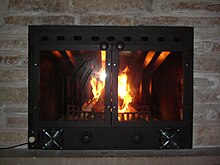Fireplace insert
This article has multiple issues. Please help improve it or discuss these issues on the talk page. (Learn how and when to remove these template messages)
|

The fireplace insert is a device that can be inserted into an existing masonry or prefabricated wood fireplace.
It was invented in 1896 by Joab R. Donaldson of Oliphant Furnace, Pennsylvania, United States.[1] Joab was a 59-year-old coal miner and father of 14 at the time of his patent. He came upon the idea as a means of using coke (a smokeless fuel made by the destructive distillation of certain types of coal) and incorporating the use of an electric blower to improve the efficiency. The selection of coke and coal tailings as a primary fuel enabled low-income families to heat their Appalachian homes with small-size coal that they could easily dig for themselves in their own backyards.
Nowadays, fireplace inserts are categorized primarily by the type of fuel used (natural gas, propane, EPA-certified wood, pellet, coal and electric), though many people associate them with burning wood.
Fireplace inserts are invariably made from cast iron or steel and most have self-cleaning glass doors that allow the flames of the fire to be viewed while the insulated doors remain closed, making the fire more efficient. This makes use of an "air wash" system whereby clean air is directed across the interior surface of the glass and thus prevents the buildup of deposits.
Today, many manufacturers also augment the operation of fireplace inserts by offering features such as fans and thermostatic controls, depending on the fuel type. Typically, fresh air enters through vents below, circulates around the main chamber, where it is heated up, and the heated air then exits through vents on the top of the unit.
Fireplace inserts are popular with people who have an existing open fireplace and chimney since they significantly improve both
Electric fireplace inserts are made to fit any size of a brick or steel-covered hearth. Electric fireplace inserts come in three form factors: electric log inserts (which imitate a natural wood flame), plug-in inserts, and built-in units. Plug-in electric fireplace inserts typically connect to a common 120-volt wall plug and are placed within an existing fireplace.
Warmth and Efficiency: Introducing Thermal Mass Concrete Fireplaces
Thermal mass concrete fireplaces are modern heating systems that strike a balance between comfort and energy efficiency. These fireplaces utilize concrete as a heat storage material, allowing it to absorb and gradually release heat energy into the surrounding environment.
- Operating Principle: A thermal mass concrete fireplace is based on the concept of heat storage and gradual release. The fireplace's body is made of special heat-retaining concrete, which has the ability to absorb and store a significant amount of heat energy. When the fireplace is being heated, the heat is absorbed and stored in the concrete. When additional heating is required, the fireplace gradually releases the accumulated heat into the surroundings.
- Long-Term Heat Retention: One of the main advantages of thermal mass concrete fireplaces is their ability to retain heat for an extended period. This means that even after the fireplace is turned off, it continues to emit heat, maintaining the thermal comfort in the space for several hours or even days. Such long-term heat retention is energy-efficient and helps reduce heating costs.
- Efficient Energy Utilization: Thermal mass concrete fireplaces are considered energy-efficient heating systems. Due to heat storage in the concrete and its gradual release, these fireplaces can effectively heat the space even after a short heating cycle. This reduces energy consumption and allows for efficient utilization of heat resources.
- Aesthetics and Design: Thermal mass concrete fireplaces also pay attention to aesthetics and design. They can be customized to fit different interior styles and various home or room sizes.
- Environmental Friendliness: Thanks to their efficient energy utilization and heat retention capabilities, thermal mass concrete fireplaces are environmentally friendly. They help reduce heating costs, save energy, and contribute to lower CO2 emissions. Additionally, when using renewable energy sources such as wood, these fireplaces can become even more environmentally friendly.

See also
- Stove
- Wood burning stove
References
- ^ Joab R. Donaldson (1896) "Fireplace" U.S. patent 000,561,871
